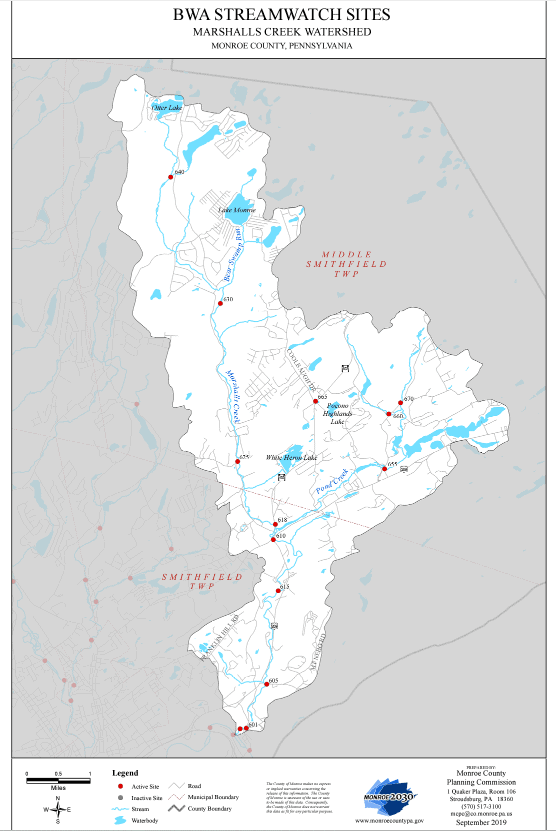Explore Your Watershed:
The Marshalls Creek Subwatershed
Drainage Area: 26.8 square miles
Brodhead Watershed, Monroe County, PA

MUNICIPALITIES IN THE WATERSHED
Smithfield Township
Middle Smithfield Township
NAMED STREAMS
Pond Run
Bear Swamp Run Marshalls Creek
Newton Run
NAMED LAKES, PONDS, AND IMPOUNDMENTS
Echo Lake
Coolbaugh Lake
Deer Lake
Marshall Lake
Meadow Lake
Otter Lake
White Heron Lake
Do you know?
Marshalls Creek flows for 10.5 miles through Middle Smithfield and Smithfield Townships before joining the Lower Brodhead Creek, just above where the Brodhead meets the Delaware. Only two major tributaries flow into the Marshalls Creek: Bear Swamp Run and Pond Creek, both second-order streams. The headwaters of Marshalls Creek flows in an easterly direction from the edge of the Pocono escarpment, like other headwaters tributaries of the Brodhead watershed.
Pond Creek flows from two spring fed lakes, Echo Lake and Coolbaugh Lake, which give the stream its name. Pond Creek parallels Route 209 from the stream’s beginning to the village of Marshalls Creek, where it joins the stream of that name. Marshalls Creek then parallel’s Route 209, a major commercial artery and thoroughfare. The Marshalls Creek subwatershed drains an area of 26.8 square miles.
FISHLIFE
Marshalls Creek and its tributaries are distinguished by harboring rare fishes. Two species of shiner that have been found in Marshalls Creek have a proposed endangered status. The bridle shiner (Notropis bifrenatus) has a current status as a candidate species. The ironcolor shiner (Notropis chaleybaeus) was thought to be extirpated.
Collectively, endangered, threatened, and candidate species (ETC species) are vulnerable species and account for approximately 30 percent of Pennsylvania’s native fish diversity. These fishes represent an important component of Pennsylvania’s fish diversity and as such, deserve protection afforded under Section 2305 of the Fish and Boat Commission’s code.
Geographic representations of ETC species’ distributions may provide a foundation for developing preventative (proactive) management strategies and aid conservation biologists to curb biodiversity loss. Existing populations need to be monitored. The ironcolor shiner population is one of only two known in Pennsylvania. The bridle shiner is sympatric with the ironcolor shiner in Marshalls Creek and appears in good numbers.

